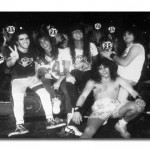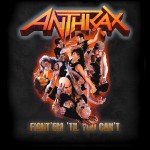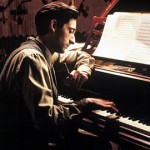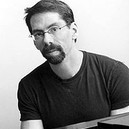I came to the internet because I wished to write deliberately: to drive life into a corner, stun it with a few well-placed hammer blows, slit its throat, hang it from a hook, and gather up its blood in buckets; to slurp the marrow from its split bones, and mill its flesh into language; to prance about wearing nothing but a skin of words, without any neighbors around to point or phone the authorities. So I built my little cabin in this hollow in the CUNY woods, beside not a pond, but a tarn—a bleak, black, stygian tarn, in whose still waters I see my cabin reflected. There are days I step into the tarn, confusing the reflection for the reality. I feel a downward suck, and know the tarn could swallow me in one cold gulp.
No House of Usher mine, though. Slapped together out of old plywood and salvaged pine, my cabin is hardly taller than I, affording me nothing more than an escape from the elements, a space to store my few worldly possessions, and above all, a hiding-place from R.W.—which is to say, from the world.
R.W.! Little did I know by how long He would outlive me. And now I am in hell, and He in some other woody place He no doubt calls heaven, and we never have occasion to see each other anymore. I admit, I do sometimes miss hearing His voice, calling to me—H.D., H.D., come out and walk with me—; and some days, when the wind whistles through the chinks in my record albums, I imagine I can still hear Him. Sometimes I turn up the volume on my headphones, my version of the wax in Odysseus’s crew’s ears, until I have blotted Him out. Other times His voice is irresistible.
Maybe it’s just loneliness.
My cabin may not look like much, but you should see it from the inside: piled high with records, and cassettes, and compact discs, dirt floor to slat roof. They act as second walls, although from the inside it’s easy to believe them the walls themselves. Up, up from my humble headquarters through the stovepipe chimney my little antenna burrows, beaming my signal out to the world, just as the chimney does the smoke from the cooking flesh of my victims. For here in my cabin, I am just one more node in a noisy global conversation.
It’s why I never let R.W. inside: He always thought I lived a Spartan life, dressed in a hair shirt, knelt to pray on broken glass. Had He found out otherwise, He’d no doubt have felt betrayed. And then He never would have invited me over anymore, and I did so like Lidian, her home cooking. One does tire of beans, beans, beans. But R.W. was so easy to fool, I almost felt bad about it. I do love Him; you just need to take Him with a great big grain of salt … which is to say, a grain will not do.
And how would I survive without Him? I am poaching on His signal, His soil. It’s not even password protected. How could it be, with His ridiculous philosophy?
It’s true, I do raise beans and meaty fruits here beside my cabin, in this fetid viper’s nest rank with death, where nothing lives but as the shadow of itself. And so I have learned to content myself with shadow-beans, and shadow-fruits, until I can’t tell the difference anymore: drop the prefix, and one comes to believe Lidian and R.W. are the real shadows. They—the beans and fruits, I mean—come up early as my thoughts; I blood them generously from bucket and trough, coax them along, harvest them when they seem ready, which is about every few weeks, if I am diligent, and not too distracted by the other business of life. As with any noxious swampland, the task of clearing and draining it was difficult; but once your labor has redeemed you, the soil is that much more venemous for it.
Did I mention that the land on which I built my cabin is part of something called “The Commons”? Leave it to R.W. to come up with such an idea. As if it didn’t all belong to Him anyway!
Nor did He ever tire of reminding me that I live on His property. Then again, because I’ve chosen the coldest, darkest corner of these Commons to live, I might as well be the exclusive proprietor—be R.W. Himself! I ask no permission to build, plant, or hunt; I have all the privacy and dominion of a king in his hunting grounds. Visitors are rare—who would want to come to such a dim, dank hollow in such an otherwise beautiful country?
And who are these rare visitors? I don’t really know. They hardly ever come within easy shouting distance—probably they are afraid of breathing the pestilential air, perhaps of contracting some obscure infection, of becoming mere shadows themselves. And then there are the carcasses I leave in a ring about a mile away, as if to suggest a predator of unimaginable voraciousness that had claimed my hollow as its hunting ground. Not surprising, then, that no one has ever approached me while I’m outside … and all the moreso that the occasional few dare to sneak up and slip a note under my door. There is the footloose Mr Foote, an itinerant tinker; he occasionally still braves these cold, swampy lowlands, waves his stick at me from a distance, not menacingly. I, less often, wave back. Sometimes an old friend sneaks through, and finding me occupied—and knowing my feelings about being interrupted in my work—slips a note under my door. Others I see less often, or from a yet-greater distance, or only from behind. Their names escape me, if I ever knew them to begin with.
I myself do get out sometimes—not often enough, perhaps. I may pay a brief visit to Mr Foote, or Mr. Picciano, out tending his garden every day, a better man than I. When I do go out walking, I am always startled by the number of abandoned properties I come across, and by the number of new, as-yet unlived-in homes as well. It makes me wonder why the newcomers don’t simply squat in the existing structures. Not that there is any problem of cluttering here, mind you. These Commons are so extensive there is hardly a place they do not reach—from the brilliant hills of Appalachia, to Scotland, Italy, even China.
But then I remember days out walking with R.W., pointing to a hill in the distance and saying, There? Your property ends there? And He would smile that cryptic smile, and say, No, past that. Just a little ways past that.
There are strangers who pass through the Commons too, of course: the occasional honest traveler, some of whom are not afraid to stop and visit, have a cup of birchbark coffee with me, talk music—all other subjects leave me dumb as a stone. Droves of salesmen, too, lugging about their coffin-heavy suitcases—I chase them away, waving my machete, howling like a berserker. But there are strangers and there are strangers. It took a long time before I realized that some of them were spies, lurkers: Pinkertons of a sort, scabs by any other name. Just the other day, I surprised one peering through the window of my cabin. Unfortunately, while giving chase I stubbed my toe on a bucket of blood, and by the time I was able to recover myself he was long gone. I did, however, find a small bundle of papers that he must have dropped in his flight, which I brought into my cabin and, under the light of the single bare bulb, set to reading. It turned out to be a report of sorts, addressed to one Dick. It read, in part, as follows:
Dear Dick:
Spent another day browsing the CUNY Academic Commons, as per your request, for heretical, satanic, blasphematory, and otherwise morally turpitudinous material. Can confirm your suspicion that the site is a cesspool of sodomite-coddling communists. Social programs, drugs, organic food, bestiality—it’s all here: the whole domino tumble from secular humanism to tax-and-sex slavery, I mean, it’s horrible, Dick, just horrible. Should be a sign that says “Shower After Browsing.” Am more concerned than ever about what our Godfearing young adults are forced to “think critically” about.
Am particularly disgusted by one site, called “Helldriver’s Pit Stop.” You’d think the name would speak for itself, but it’s actually worse. A general tone of mocking the Creator. Seems like the only way author can make a point is by using foul language, or taking the Lord’s name in vain. Author claims atheism, but seems obsessed with religion—you know, the typical secular hypocrisy. And talk about worshipping false idols! […]
It went on like this for another six or so pages.
Luckily, I also found a card among the papers with said Dick’s full name and address. Rest assured I have set about amending the language of the report. Oh, not so much, really—a few corrections here and there … a little more attention to … ahem … word choice. I only wish I could be there to see what happens to my unnamed Pinkerton when the amended report arrives.
*
Ever since reading the comments from two visitors of apparently evangelical orientation on Tony Picciano’s post about Michele Bachman’s gaybashing last July, I’ve wondered to what extent the Commons is trawled for soundbites by the minions of the religious right. It probably should have occurred to me earlier—after all, CUNY is the home of the dreaded Frances Fox Piven, bitch Eve of the American fall, and her imps canker the campuses of Sodomanhattan and the Gomorrahs of the boroughs. Ah, to be an educator in a time when education itself is considered radical! And so I must admit a vague disappointment at not having become (at least to my knowledge) the target of someone’s righteous anger. Why isn’t anyone commenting on my suspect morality? Why isn’t anyone except my neighbor (my actual, physical neighbor) telling me I’m going to hell? Not that I have any interest in seeing the sainted crosshairs around my mugshot. But an outraged comment or two would really be a shot in the arm. It would be a whole lot better than the spam, spam, spam, spam, spam …
Ah, Helldriver, expurgate thyself. The virtually unlimited nature of virtual space hath made a blatherer of thee. Secretly thou cravest the editor’s bridle and crop.
Pray tell, what editor in his or her right mind would allow me to end anything with the sentence “And then I woke up”? Any of you who have not felt such an urge at one time or another, feel free to cast the first stone … but wait until you have your own blog first!
Blather aside, this is supposed to be an end-of-the-second-year roundup (and, very much in the spirit of my namesake, I will allow my two years to bleed into one). Over the last year I didn’t post quite as frequently as I’d have liked—only 15 posts, as compared to 24 the first year. But it would be incorrect to say my output has dwindled, since the average length per post has increased. Conclusion: I humiliate myself less often, but at greater length; where once I apologized for writing 2,500 words, I now gleefully plop down 5,000. To be honest, I didn’t expect to spend a month writing an article-length post about Anthrax. Summer is one thing, but during the school year? O, how I look forward to the next few short-and-sweet posts …
But to the past. Regarding what Brian Foote called the “sartorial duties” of bandleader Ron Carter (“No Tie-Picker He,” 6.20.10): when I saw Carter last fall at the Highline Ballroom, the whole band (he, Mulgrew Miller, and Russell Malone) were wearing matching rainbow ties. Since this was right around when the legislature was set to vote on marriage equality, I took it as a statement. I actually missed the beginning of the set, so for all I know Carter might have mentioned it.
I got a chance to see Fred Hersch’s trio again at the Village Vanguard this February; the last time Hersch played there, I was so moved by the Sunday night set that I was compelled to write about it (“Double Time,” 8.16.11). I must have been trying to reproduce the experience—knowing full well that such experiences are not reproducible—because I chose to go on Sunday again. He played some of the same tunes, including the same encore—yes, the encore I made such a to-do about last August. Overall, though, it was a very different set: low-key, playful without being rambunctious; a winding down of the week’s residency rather than its apotheosis.
As I continue to plow through the BFI anthology Early Cinema, and after listening to John Zorn’s comments in the documentary Put Blood in the Music (which I don’t recommend unless you’re a real big fan of Sonic Youth), I’m almost ready to start thinking about reconsidering some of my points in two separate posts, “On Bands” (8.5.10) and “Silent Movie” (3.25.11). Some of Zorn’s comments focused on the way television, cartoons in particular, have changed the way he (and his generation) think about musical structure. Since this is not a matter of correcting or rethinking a point or two, but of making a whole new argument, my comments will take the shape of a whole new post. By writing this paragraph, I’m sneakily trying to commit myself to get to it before next April.
I’m sure I’ll have things to say about “Glee Metal” (3.17.12), the second of two Tolstoy-length posts about metal, once I’m a little further away from it (besides the amusing fact that Candlebox is playing the Gramercy Theater next month). As for the first (“Burned-over,” 8.3.11), two points. (1) The July 2011 unrest in England—and similar unrest over the previous months in EU stepchildren Spain and Greece—suggest that it was a bit myopic of me to dismiss “defuse anger at the state of things” as a cultural catalyst. My broader point, though, was that rather than making a sweeping gesture at the recession and then pointing a finger at “angry” music, we need to be careful about arguing the connections between history and the evolution of aesthetic forms. In this regard, the recent popularity of ‘80s metal needs to be considered according to a wide range of determinants, many of them purely aesthetic: the dissemination of elements of heavy metal’s musical discourse into a variety of other genres; many young bands’ open admissions of debt to their ‘80s precursors, now lumped together with “classic rock”; the growth of the nostalgia industries, which seem to have moved on to the ‘80s after turning the ‘70s into a stripmined moonscape; and the propensity to read musical kinships through the lenses of irony, kitsch, and retro-. Once we’re done talking about all this, then maybe we can talk about the economy, racism, etc.—but again, specifically (e.g., Scandinavian black metal and right-wing nationalism). (2) My assertion that thrash metal evolved into a more progressive style between its inception and its demise (roughly 1983-1990) needs to be complicated. I think a closer look would reveal various strands of change, from the more progressive to retro-punk, alternative, and industrial, as metal bled into surrounding genres and vice-versa, through the convergence of audiences accommodating themselves to the new, more aggressive sound, and metal growing to accommodate a wider audience. In terms of my point in “Burned-over,” this means that, with Infected Nations, Evile is recapitulating a certain strand of the genre’s evolution, but not the genre as a whole.
Finally, ever since reviewing Best Music Writing 2011 (1.9.12) I’ve wondered whether I wrote a Trojan horse against affirmative action. Not my intention. My point was that it should not be the responsibility of a “best of” anthology to reflect all the nuances of the historical (musical) moment, but rather to showcase as diverse as possible a range of great writing. An anthology’s not a university … Enough! or Too much.
*
I sometimes wonder how the hell I ended up with a doctorate in English. I was never the Smiths-loving high schooler with the soul of a poet. Portrait of the Artist did nothing for me, except for the “horrors of hell” sermons. I don’t think I finished Billy Budd. Bo-ring. Crime and Punishment, what a drag. And all this despite having really great English teachers. (Take heart, all you teachers out there, and remember Helldriver when you are losing patience with your students.) My first two years of college I was a physics major, and I kept on taking science courses as electives after switching majors. But there was something else I was doing the whole time that served as a thread linking everything together, and keel and rudder for wherever I happened to be going. I came to literature through a back door, figuring that if I wanted to write, I should have a better idea about how the craft had been practiced in the past. I had somehow managed to get a B.A. in The Writing Seminars with only three straight-up lit classes under my belt. (Do the seams show? It’s all homespun.)
With music, the story is somewhat different. I grew up with it all around me. But the trajectory has been similar: wanting to write about music has opened doors I would otherwise have been disinclined—whether too scared, lazy, or just too preoccupied with other things—to open. Writes Jacques Barzun: “Perhaps it [music] must be talked about if it is to give its devotees full measure in enjoyment and significance.” Or, perhaps it is the desire to talk about it, to articulate and find meaning in what we hear, that predisposes us to apply our emotional and critical faculties most fully.











